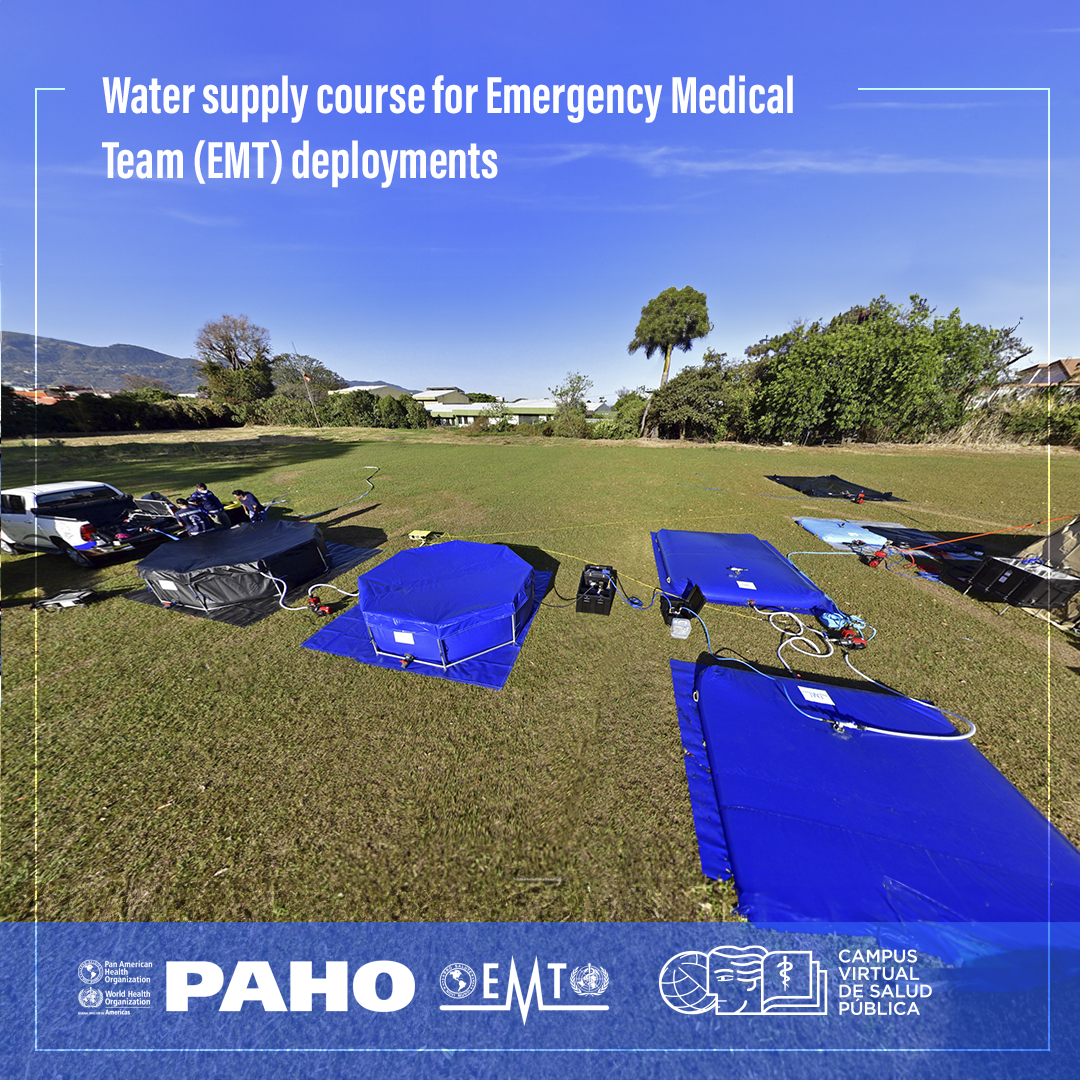
VERSIÓN ESPAÑOL ENGLISH VERSION VERSION FRANÇAISE
Introduction to Water Supply in EMT Deployments
This course is part of the WASH capacity-building process for Emergency Medical Teams (EMTs) in the Americas region. It accompanies the EMT Ignite webinars held during the response to the COVID-19 pandemic, as well as the donations of water treatment kits, based on the same process explained in this course. These kits have been provided to national EMTs in the region to strengthen local and regional health response mechanisms through improved self-sufficiency.
Course Program
Introduction to the Course
Emergency Medical Teams (EMTs) are groups of health professionals comprising doctors, nurses, first aid technicians, and logistics experts, among others, who provide clinical care to people affected by an emergency. They come from governments, charities, non-governmental organizations (NGOs), the military, civil protection bodies, international humanitarian networks (including the International Red Cross and Red Crescent Movement), Médecins Sans Frontières (MSF), teams contracted by the United Nations, and the private for-profit sector. They work to minimum standards agreed upon by the EMT community and its partners and are deployed with the necessary training and self-sufficiency so as not to overburden an already stressed national system.
As part of self-sufficiency, the capacity to supply water during the days that the EMTs are deployed must be demonstrated. Therefore, they must have the necessary equipment and consumables, as well as the technical know-how to effectively carry out the supply process, from water collection to consumption, including transportation, storage, treatment, and disinfection.
This introductory course on water supply in EMT deployments aims to provide people involved in the deployment and operation of this equipment with the tools and knowledge necessary to be prepared and respond quickly and timely to emergencies, disasters, and pandemics, reaching the minimum technical standards recommended by WHO/PAHO. The course covers the following areas related to water supply: catchment, transport, storage, pretreatment, filtration, residual disinfection, distribution, and water analysis.
Purpose
The purpose of this course is to provide basic theoretical knowledge that will allow for the proper implementation of a water supply system in an Emergency Medical Team and improve its self-sufficiency and safety during its deployment.
Objectives
At the end of the course, participants will be able to:
- Understand what is involved in having a water supply system in an EMT.
- Understand how to make a correct selection of the capture point in a deployment.
- Decide how to transport water during an emergency response.
- Calculate the number and type of tanks and how to store water in an EMT.
- Define the preliminary procedures needed to prepare water for filtration.
- Select the desired filtration equipment in an EMT system for water supply.
- Apply basic knowledge to perform residual chlorination of water.
- Design and obtain a water distribution system in an EMT.
- Acquire and operate the necessary equipment for water analysis during EMT.
Target Audience
This introductory course on water supply in an EMT is intended for all related Emergency Medical Team operational personnel involved and/or interested in the design, equipment procurement, and operation of the potable water supply process during an emergency, disaster, and pandemic response deployment.
Course Duration
Two hours.
Course Modality
Self-paced (self-learning) course, free of charge, open to the public, and with no deadlines for completion.
Course Structure
Session 0: Introduction to the Course
- Animation 1: Theory
- Audiovisual 1: Visual example
- Confirmation of Knowledge 1 (5-question test, 10 minutes)
Session 1: Recruitment
- Animation 1: Theory
- Audiovisual 1: Visual example
- Confirmation of Knowledge 1 (5-question test, 10 minutes)
Session 2: Transportation
- Animation 2: Theory
- Audiovisual 2: Visual example
- Confirmation of Knowledge 2 (5-question test, 10 minutes)
Session 3: Storage
- Animation 3: Theory
- Audiovisual 3: Visual example
- Confirmation of Knowledge 3 (5-question test, 10 minutes)
Session 4: Pretreatments
- Animation 4: Theory
- Audiovisual 4: Visual example
- Confirmation of Knowledge 4 (5-question test, 10 minutes)
Session 5: Filtration
- Animation 5: Theory
- Audiovisual 5: Visual example
- Confirmation of Knowledge 5 (5-question test, 10 minutes)
Session 6: Residual Chlorination
- Animation 6: Theory
- Audiovisual 6: Visual example
- Confirmation of Knowledge 6 (5-question test, 10 minutes)
Session 7: Distribution
- Animation 7: Theory
- Audiovisual 7: Visual example
- Confirmation of Knowledge 7 (5-question test, 10 minutes)
Session 8: Water Analysis
- Animation 8: Theory
- Audiovisual 8: Visual example
- Confirmation of Knowledge 8 (5-question test, 10 minutes)
Evaluation and Certification
After each session, participants are required to take a short assessment that allows them to reinforce the knowledge acquired. The evaluation offers the participants multiple opportunities to answer correctly until they obtain the required score of at least 70%. Participants who meet this requirement in all knowledge confirmation evaluations and complete the Quality Survey of the Virtual Campus for Public Health (VCPH) will be able to download their certificate of course completion issued by the Pan American Health Organization.
References
A document of bibliographical references used for the development of the course content can be found on the course platform.
Acknowledgments
The content of the Spanish edition of this course was developed in collaboration with the EMT teams of Costa Rica, Panama, and Mexico, in addition to the support of experts from the PAHO Regional EMT Secretariat.
